Chapter 39.20
HOUSING TRENDS

Sections:
39.20.020 2010 Comprehensive Plan goals and policies.
39.20.030 Orchard Mesa housing trends.
39.20.010 Background.
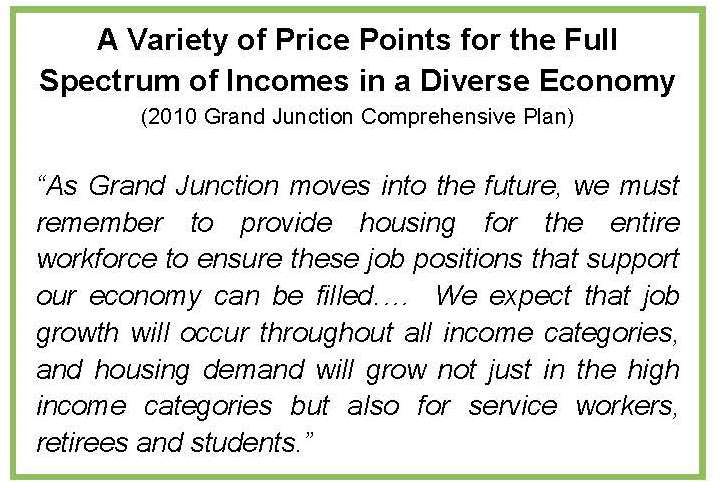
(a) According to the 2010 U.S. Census, the Orchard Mesa Plan area had about 6,424 housing units, with an occupancy rate of 95 percent. (Mesa County Assessor’s records show about 6,580 dwelling units as of 2013.) The average household size for the plan area was 2.56 people per household, above the Mesa County average of 2.46 and the City of Grand Junction average of 2.19. In the Orchard Mesa Census Designated Place (CDP), the average household size for renters is 3.54, while the average household size for owners is 2.46 (U.S. Census Bureau American Community Survey, 2011).
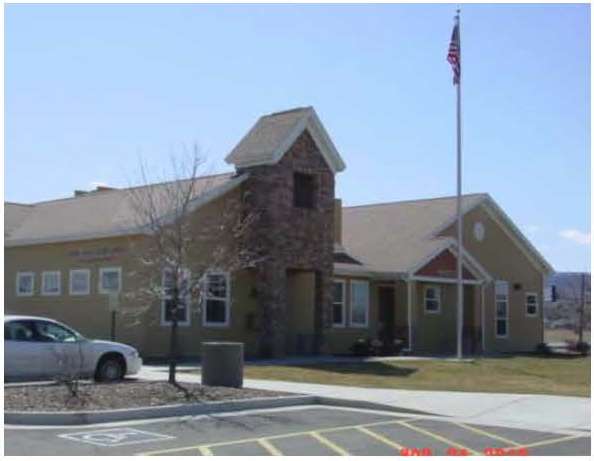
(b) Home ownership rates for the Orchard Mesa Plan area are higher than Grand Junction and Mesa County, at about 75 percent. (Table 3) The Census Bureau tabulates data for the Orchard Mesa Census Designated Place (CDP), which is the unincorporated area west of about 30 Road. The Orchard Mesa CDP is the more densely populated portion of the unincorporated area, but it includes most of the newer single-family developments, of which 83.3 percent are owner-occupied. The rural agricultural area has an even higher owner occupancy rate, at 85.3 percent. The westernmost portion of the plan area is in the City of Grand Junction and represents 47 percent of all households in the area. The older, more dense area has a lower proportion of owners, with 65 percent of homes owner-occupied, but it is still above the owner occupancy rate for the City as a whole.
|
|
Occupied Households |
Owner-Occupied |
Renter-Occupied |
|---|---|---|---|
|
Orchard Mesa Plan Area |
6,105 |
74.7% |
25.3% |
|
– Orchard Mesa, incorporated |
2,959 |
64.5% |
35.5% |
|
– Orchard Mesa CDP |
2,494 |
83.3% |
16.7% |
|
– Orchard Mesa, rural |
652 |
85.3% |
14.7% |
|
City of Grand Junction |
24,311 |
62.4% |
37.6% |
|
Mesa County, all unincorporated |
27,502 |
79.2% |
20.8% |
|
Mesa County, all |
58,095 |
71.4% |
28.6% |
Source: 2010 Census
(c) Data for the Orchard Mesa CDP includes information that can give a general view of Orchard Mesa households, reflecting the average conditions and demographics of the overall plan area (U.S. Census Bureau American Community Survey, 2011). In 2011:
(1) About 44 percent of the residents in the Orchard Mesa Plan area lived in the CDP. (Forty-eight percent of residents lived in the incorporated area and the remaining eight percent lived in the rural area.)
(2) Nearly half of the residents moved in after 2005.
(3) About 75 percent of owner-occupied households had a mortgage; the median mortgage payment was $1,375.
(4) Median rent was $1,008. About 37 percent of renters paid more than 35 percent of their household toward rent. Typically, a household paying more than 30 percent of its income towards housing costs, including utilities, is considered to be at a high risk of being economically insecure.
(5) About 14 percent of the population was age 65 or older, while 25 percent was under age 18. These numbers closely match Mesa County as a whole.
(6) As with all of Grand Junction and Mesa County, the percentage of the population age 65 and older on Orchard Mesa will increase over the next 20 years; about 25 percent of the current population in the CDP is between the ages of 45 and 64.
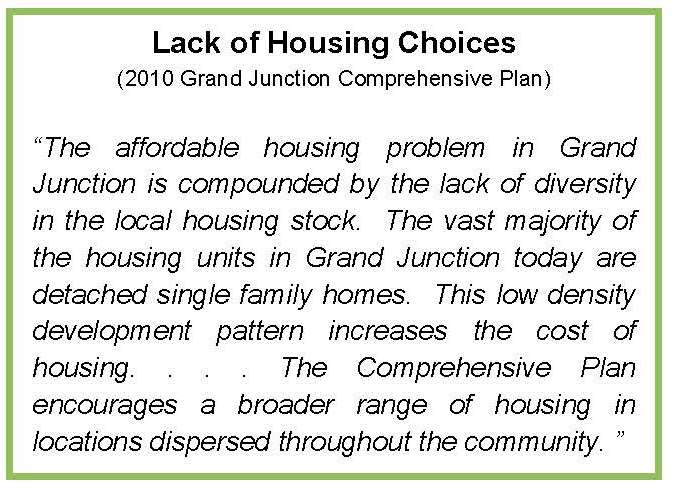
(7) The median age was 34.6 years. This is significantly younger than Grand Junction’s median age of 36.7 and Mesa County’s median age of 38.1 years. The lower median age indicates the presence of young families.
(d) In the Orchard Mesa Plan area, single-family residences account for 91 percent of all dwelling units (Table 4). The preponderance of single-family homes suggests the housing needs of many people may not be met, including seniors, lower-income families, disabled persons and students. Townhomes, condominiums, duplexes and triplexes reflect seven percent of the housing stock, while the remaining two percent of the dwelling units are in multifamily developments of four units or more. The average floor area for a single-family residence is about 1,559 square feet. Houses on agricultural properties tend to be much larger, averaging 2,220 square feet. The average size for dwellings in townhome and multifamily development ranges from 829 to 1,129 square feet.
|
Type |
Total Dwelling Units |
Average Floor Area |
|---|---|---|
|
Single-Family Residence |
5,181 |
1,559 s.f. |
|
Single-Family, Ag Residence* |
829 |
2,220 s.f. |
|
Townhome |
283 |
1,192 s.f. |
|
Condominium |
31 |
829 s.f. |
|
Duplex/Triplex |
165 |
1,058 s.f. |
|
Multifamily, 4-8 units |
82 |
823 s.f. |
|
Multifamily, 9 + units |
298 |
1,090 s.f. |
Source: 2013 Mesa County Assessor’s Records and GIS
*Ag residence denotes a single-family residence on a property classified by the Mesa County Assessor as an Agriculture land use.
(e) The largest multifamily development is Monument Ridge Townhomes located at 2680 B 1/2 Road; it has 166 units totaling 190,095 square feet. It is a privately owned rental complex but as a housing tax credit project, residents for some of the units must meet income qualifications. Other large multifamily developments include Linden Pointe located at 1975 Barcelona Way, with 92 units, and Crystal Brook Townhomes located at 1760 LaVeta Street, with 40 units. These two properties are owned and operated by the Grand Junction Housing Authority. Both have income requirements for tenants. The affordable housing stock on Orchard Mesa is rounded out by 12 duplexes on Linden Avenue, owned by Housing Resources of Western Colorado. The western plan area includes several privately owned mobile home parks, which may include older pre-HUD (1976) homes. (There are approximately 250 pre-HUD homes in the plan area.) While not officially classified as affordable housing, these older, often obsolete structures fill a need for lower-income housing.
(f) During periods of economic challenges, housing foreclosures increase and residents find themselves with a lack of affordable housing. Resulting impacts include limited availability of rental properties, higher rents, and overcrowding. The Grand Junction Housing Authority and other entities assist homeowners with foreclosure prevention counseling and workout options.
(g) The average year built for single-family residences is 1978, while the median year built is 1979. The oldest residences date back to 1890. Only a quarter of the housing stock is more than 50 years old. Orchard Mesa saw significant construction booms in the 1950s, 1970s, and 2000s; the decades following boom periods are all marked by significant declines in the number of new houses built (Figure 6). The average value in 2013 of a single-family residence was $170,545 (Table 5). Since the last housing boom there are a number of residentially zoned properties that are still vacant (Appendix Map 9).
Figure 6: Residences by Year Built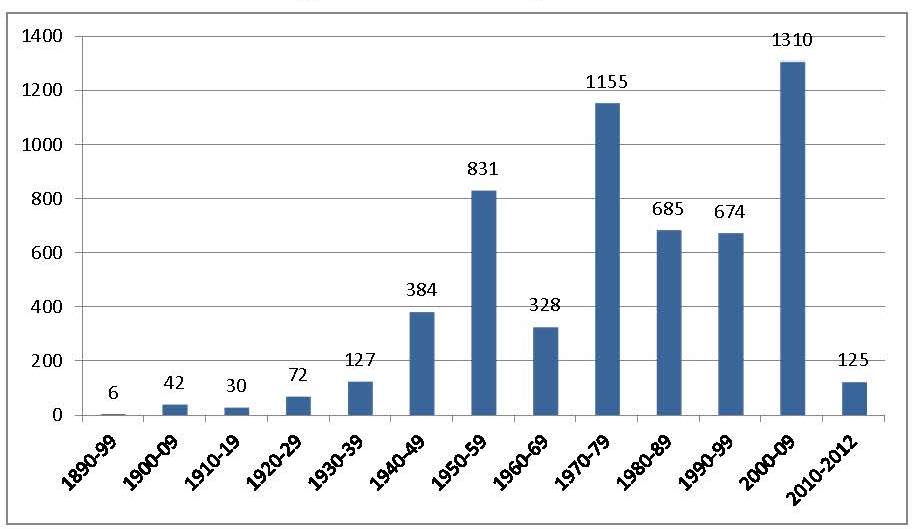
|
|
Average |
Total |
Minimum* |
Maximum* |
|---|---|---|---|---|
|
Land |
$55,795 |
$289,073,380 |
$3,690 |
$288,750 |
|
Improvements |
$114,750 |
$594,520,700 |
$760 |
$664,910 |
|
Total |
$170,545 |
$883,594,080 |
$760 |
$844,910 |
Source: 2013 Mesa County Assessor’s Records and GIS
*Minimum and maximum are by each valuation category and do not reflect two single properties
(h) The Grand Junction Comprehensive Plan’s Blended Residential Land Use Categories Map (Figure 7) allows for a broader range of density within the same land use classification, allowing for the development of varied housing types (single-family, duplex, multifamily), thereby giving the community more housing choice. Providing housing for families and singles for all life stages is important in creating a community that is livable and vibrant.
Figure 7: Blended Residential Map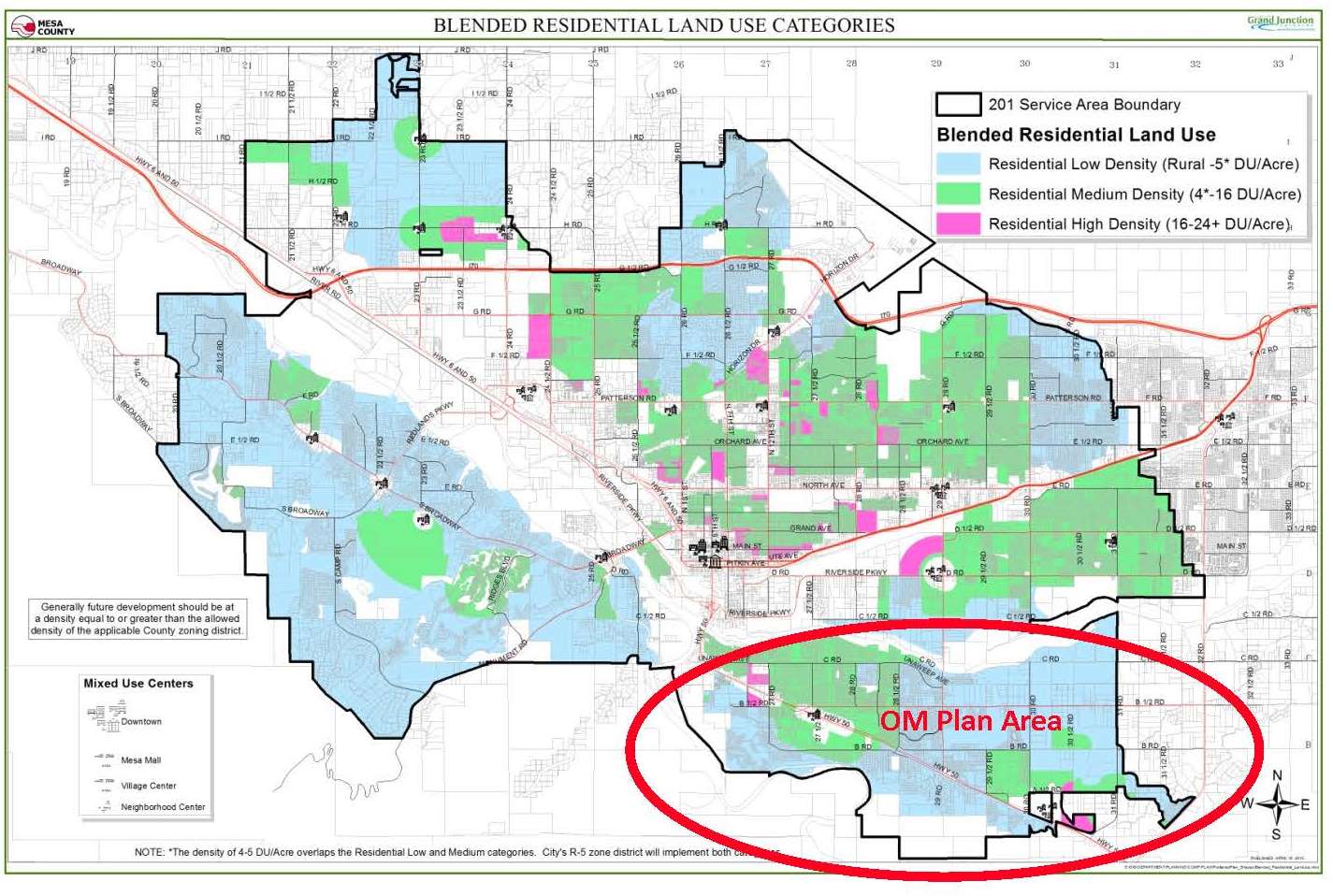
(Ord. 4629, 5-7-14)
39.20.020 2010 Comprehensive Plan goals and policies.
(a) Goal 5. To provide a broader mix of housing types in the community to meet the needs of a variety of incomes, family types and life stages.
(1) Policies.
(i) In making land use decisions, the City and County will balance the needs of the community.
(ii) Encourage mixed-use development and identification of locations for increased density.
(iii) Increase the capacity of housing developers to meet housing demand.
(Ord. 4629, 5-7-14)
39.20.030 Orchard Mesa housing trends.
(a) Goal 1. A broad mix of housing types is available on Orchard Mesa to meet the needs of a variety of incomes, family types, and life stages.
(1) Actions.
(i) Identify and maintain an inventory of vacant parcels suited for housing and determine infrastructure needs for future development of those parcels. Coordinate improvements that will facilitate construction of more diverse types of housing with capital improvement plans.
(ii) Implement through zoning the opportunity for housing alternatives where appropriate, such as multifamily within commercial zones, accessory dwelling units, and HUD-approved manufactured housing.
(iii) Implement the Blended Residential Land Use Categories Map to provide additional housing opportunities within the Orchard Mesa Plan area.
(iv) Continue to work with housing partners in the Grand Valley to develop and implement housing strategies, referencing the 2009 Grand Valley Housing Strategy report as background and guidance.
(b) Goal 2. Housing on Orchard Mesa is safe and attainable for residents of all income levels.
(1) Actions.
(i) Work with housing partners such as Housing Resources of Western Colorado to provide information to residents on the availability of income-qualified housing rehabilitation and weatherization programs. Utilize public and private funding available for such improvements.
(ii) Work with neighborhood groups to educate residential property owners about programs that are available for foreclosure prevention, in order to preserve and stabilize neighborhoods during periods of economic challenges.
(iii) Work with housing partners and the development community to identify unmet needs in the housing market, and resolve regulatory barriers that would otherwise prevent such housing from being built.
(iv) Work with owners of mobile home parks to replace non-HUD mobile homes with HUD-approved manufactured homes, and to improve the overall appearance of the parks.
(c) Goal 3. Neighborhoods on Orchard Mesa are safe and attractive.
(1) Actions.
(i) Maintain a neighborhood association database and provide sources for technical assistance to forming such associations.
(ii) Offer neighborhood services (block parties, etc.) to neighborhoods within and outside the City in partnership with Mesa County.
(iii) Coordinate the work of City and County code enforcement in areas where jurisdiction may abut or overlap.
(iv) Provide information to homeowners on resources available to those unable to maintain their properties.
(v) Work with landlords to address property management and maintenance concerns.
(Ord. 4629, 5-7-14)


